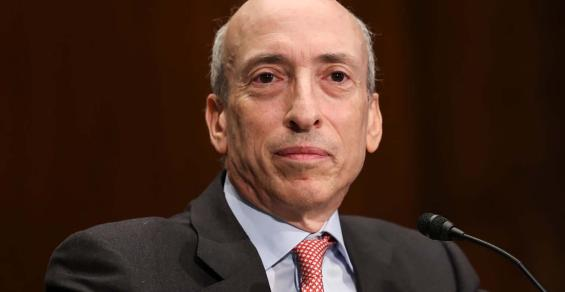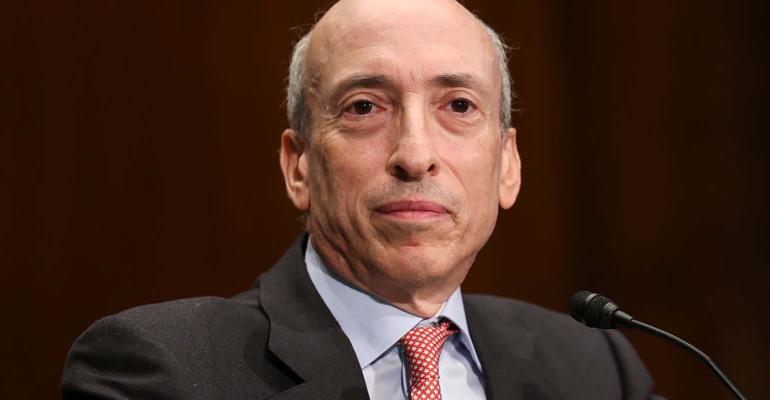
SEC Imposes Money-Market Fund Rules to Thwart Rapid Outflows
 Kevin Dietsch/Getty Images News/Getty Images SEC Chair Gary Gensler Investment>Mutual Funds SEC Imposes Money-Market Fund Rules to Thwart Rapid Outflows The new rules are meant to discourage runs like the one in March 2020 and shield remaining shareholders from costs tied to the high level of redemptions.
Kevin Dietsch/Getty Images News/Getty Images SEC Chair Gary Gensler Investment>Mutual Funds SEC Imposes Money-Market Fund Rules to Thwart Rapid Outflows The new rules are meant to discourage runs like the one in March 2020 and shield remaining shareholders from costs tied to the high level of redemptions. (Bloomberg) -- Money-market funds are getting their biggest rules overhaul in years after Wall Street’s top regulator finalized rules to stem rapid outflows during times of financial stress.
The US Securities and Exchange Commission decided Wednesday to require fees that will significantly affect parts of the $5.5 trillion industry. However, the regulator won’t require “swing pricing” for the funds after fierce pushback from the industry.
The new rules are meant to discourage runs like the one in March 2020 and shield remaining shareholders from costs tied to the high level of redemptions. After the pandemic’s onset roiled markets, the Federal Reserve was forced to step in to rescue money-market funds for the second time in 12 years, leading to calls for the SEC to impose tougher regulations.
Under the finalized regulations, some funds will face mandatory liquidity fees after the final rule was approved by three of the commission’s five members. The fees would kick in after a one-year implementation period for institutional prime and institutional tax-exempt funds when daily redemptions surpass 5% of net assets.
“I believe that liquidity fees, compared with swing pricing, offer many of the same benefits and fewer of the operational burdens,” SEC Chair Gary Gensler said. Taken together, the new rules will make money-market funds more resilient, he added.
Read more: Money-Market Funds Brace for Biggest Regulatory Revamp in Years
Swing pricing is essentially a fee imposed on investors redeeming shares in money-market funds by adjusting a fund’s net asset value. Mass redemptions can increase costs to a fund and dilute remaining shareholders’ assets.
The mechanism is widely used in Europe. The SEC proposal in December 2021 would have made the measure mandatory, specifically for institutional prime and institutional tax-exempt money-market funds.
Industry ReprieveThe reprieve on a swing-pricing requirement marks a significant victory for JPMorgan Chase & Co.’s asset management unit, State Street Corp. and Federated Hermes Inc., which had opposed the measure. Among the complaints were that swing pricing would drive up investor costs and lead to a significant decrease in institutional money-market funds’ assets.
Still, the move didn’t satisfy critics. The shift to a liquidity fee as an alternative to swing pricing “is hardly a full-throated endorsement” by money-market funds, Republican Commissioner Hester Peirce said during the meeting.
That sentiment was swiftly echoed by some in industry, including Investment Company Institute Chief Executive Officer Eric Pan, who said by email that the SEC “has missed the mark” by forcing some funds to adopt costly and complex fees. ICI is a trade group representing money-market funds.
Time to ComplyPeirce, one of two Republicans on the SEC, also cautioned that firms would benefit from additional time to implement the fee.
However, William Birdthistle, who leads the SEC’s investment management division, said that the implementation period was sufficient because money-market funds can take advantage of their experience with the existing liquidity-fee framework, which is less onerous than swing pricing.
The other point of contention for the industry was forcing government funds to convert to a floating net asset value in the event of a negative interest-rate environment. Under the final rule, these vehicles have the choice to convert to a floating share price or by reducing the number of shares outstanding to maintain a stable net asset value per share.
Some funds will also see their minimum daily and weekly liquid asset requirements rise to 25% and 50%, respectively, from the current levels of 10% and 30%. “This will provide a more substantial buffer in the event of rapid redemptions,” Gensler said.
The SEC said that the industry will have a transition period to comply.
TAGS: Regulation & Compliance 0 comments Hide comments Comment * Switch to plain text editor
Comment * Switch to plain text editorMore information about text formats
Text format CommentsPlain text Comments- Allowed HTML tags: <em> <strong> <blockquote> <br> <p>
- No HTML tags allowed.
- Web page addresses and e-mail addresses turn into links automatically.
- Lines and paragraphs break automatically.
- Load More
- Next Article
Owl Media Group takes pride in providing social-first platforms which equally benefit and facilitate engagement between businesses and consumers and creating much-needed balance to make conducting business, easier, safer, faster and better. The vision behind every platform in the Owl Media suite is to make lives better and foster a healthy environment in which parties can conduct business efficiently. Facilitating free and fair business relationships is crucial for any thriving economy and Owl Media bridges the gap and open doors for transparent and successful transacting. No advertising funds influence the functionality of our media platforms because we value authenticity and never compromise on quality no matter how lucrative the offers from advertisers may seem.
Originally posted on: https://www.wealthmanagement.com/mutual-funds/sec-imposes-money-market-fund-rules-thwart-rapid-outflows